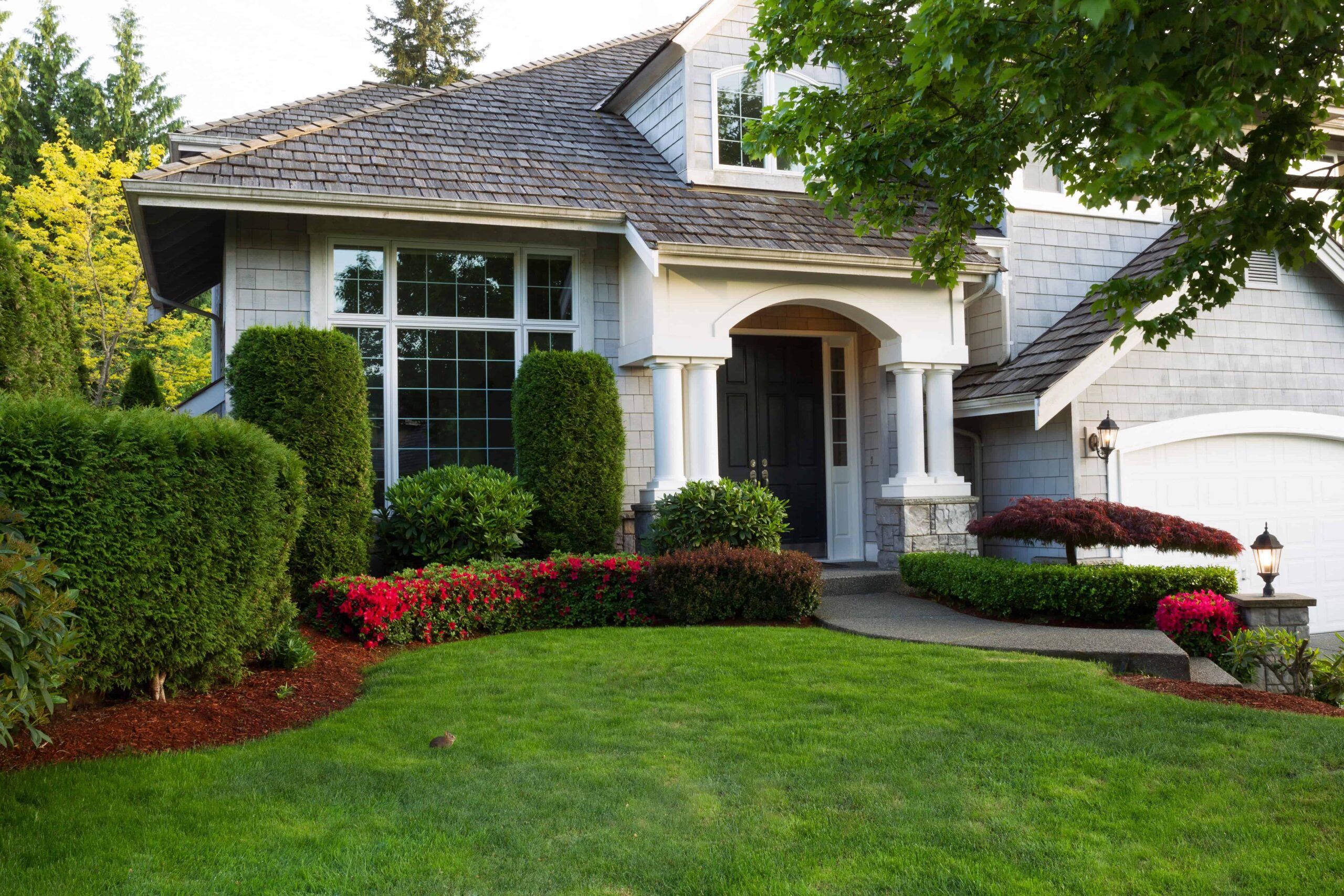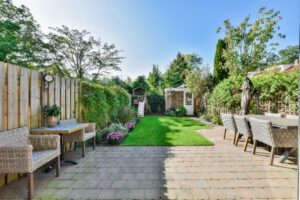Your front yard should welcome you home, not greet you with a never-ending to-do list.
If weekends spent mowing, weeding, and babying fussy plants sound exhausting, it’s time for a low-maintenance front yard landscaping that works for you.
Want to know my secret? It’s all about choosing plants that practically care for themselves, designing with your sanity in mind, and using sneaky shortcuts that neighbors will never notice.
No matter if you’re a time-crunched parent, a jet-setter, or just someone who thinks ‘yard work’ should be optional, these 15 solutions will give you back your weekends.
1. Clover Lawn – The No-Mow, No-Fuss Alternative
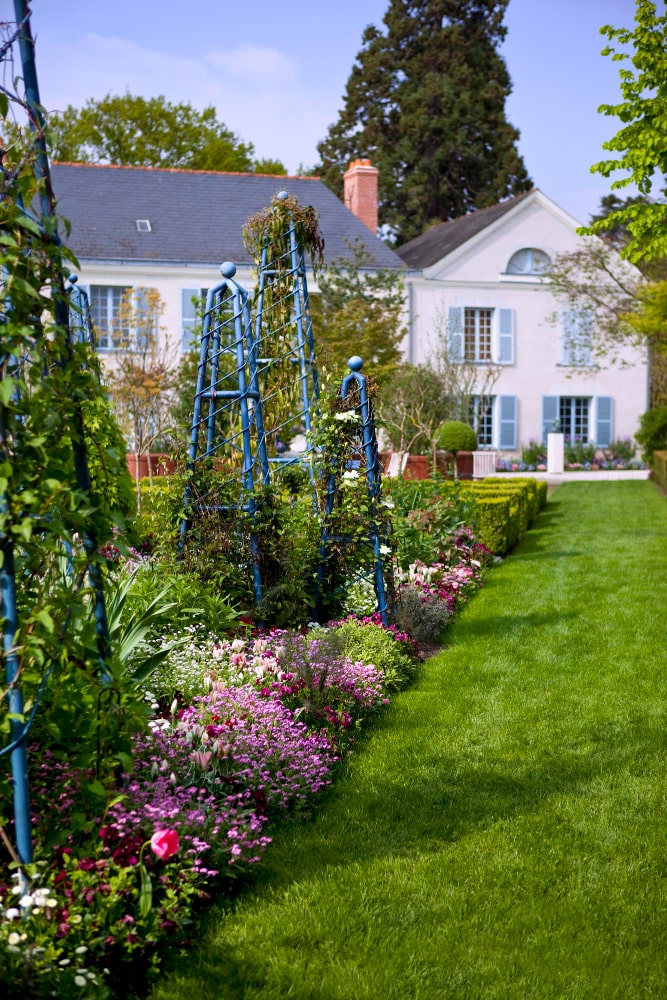
That pristine green grass? It’s a high-maintenance diva. Swap it for a clover lawn—softer underfoot, drought-resistant, and naturally fertilizes itself. Plus, bees adore the tiny white flowers.
Why it works:
- Grows just 4-6 inches tall (no mowing needed)
- Stays green even in drought
- Chokes out weeds naturally
Pro tip: Mix with creeping thyme for a fragrant, walkable ground cover.
2. The ‘Survivor’ Plant Squad – Tough Beauties That Thrive on Neglect

These plants laugh in the face of neglect while still looking gorgeous:
- Sedum’ Autumn Joy’: Changes colors seasonally, ignores drought
- Russian Sage: Wispy purple plumes that deer won’t touch
- Liriope: Grass-like edging with purple summer blooms
Real talk: Group them by water needs so your irrigation does the heavy lifting.
3. Use Mulch to Reduce Weeds and Watering
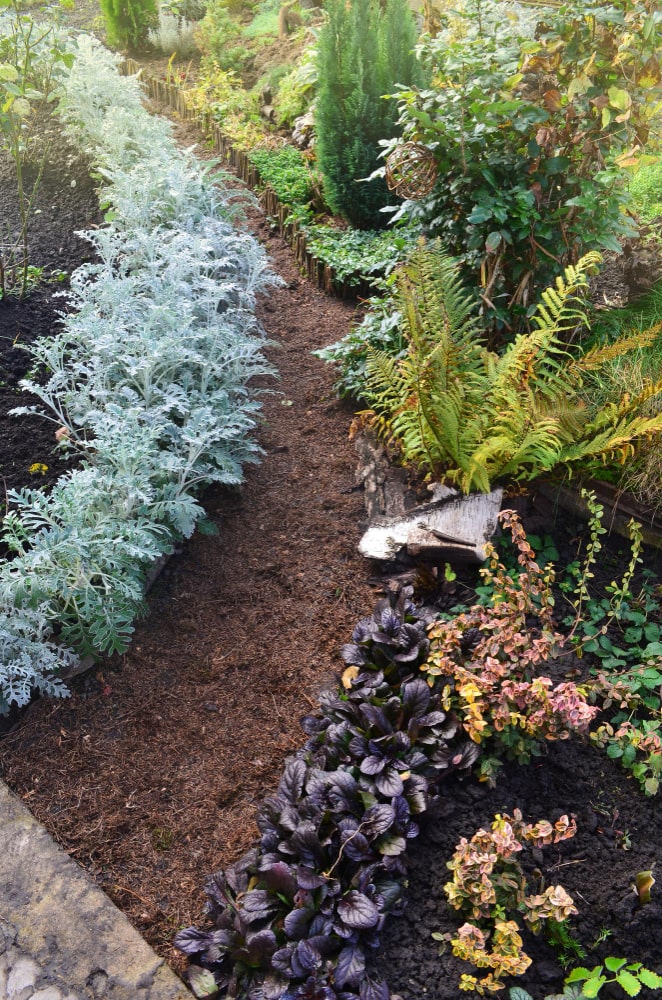
Mulch is the unsung hero of low-maintenance landscaping, offering multiple benefits:
Types of Mulch:
- Bark chips: The classic choice that breaks down slowly, enriching your soil as it decomposes. Look for larger nugget sizes (2-3 inches) that stay in place better than shredded varieties.
- River rock: Ideal for hot, dry climates where organic mulches might decompose too quickly. Those stones work like nature’s battery – soaking up the warmth when the sun’s out and gently releasing it after dark, giving your plants a cozy little climate boost.
- Straw: An excellent temporary mulch for vegetable gardens or newly seeded areas. It’s lightweight and inexpensive but needs replacing annually.
Application Tips:
- Always start with weed-free soil
- Apply 3-4 inches of mulch (but keep it a few inches away from plant stems)
- Refresh organic mulches annually as they decompose
- For extra weed protection, lay cardboard or several layers of newspaper under the mulch
Bonus Benefit: Mulch regulates soil temperature, protecting plant roots from extreme heat and cold.
Related Content: Small Front Yard Landscaping Ideas
4. Incorporate Hardscaping for Permanent Structure

Hardscaping means all the ‘hard stuff’ in your yard – think stone walkways, concrete patios, retaining walls, and other permanent structures that don’t need watering or pruning.
These elements provide year-round structure without any maintenance beyond occasional sweeping or rinsing:
Popular Low-Maintenance Options:
- Flagstone pathways: Natural stone paths blend beautifully with any landscape style. The irregular shapes mean you don’t need perfect edges, and weeds have trouble growing between properly installed stones.
- Dry creek beds: These decorative gravel channels solve drainage problems while adding visual interest. Use a mix of stone sizes for a natural look, and include a few larger boulders as focal points.
- Raised stone planters: Contained planting areas mean no grass creeping into flower beds. That vertical pop takes a blah flat yard and gives it some personality – plus, the stone stays looking great year after year with zero fuss: no painting, no staining, just timeless good looks.
Design Considerations:
- Use local stone to blend with your region’s natural aesthetic.
- Curved lines look more natural and are easier to maintain than sharp angles.
- Make sure water can drain properly – nobody wants a swampy mess after it rains.
- Consider scale – large yards can handle bigger features, while small spaces need more delicate elements.
5. Install Smart Irrigation for Effortless Watering
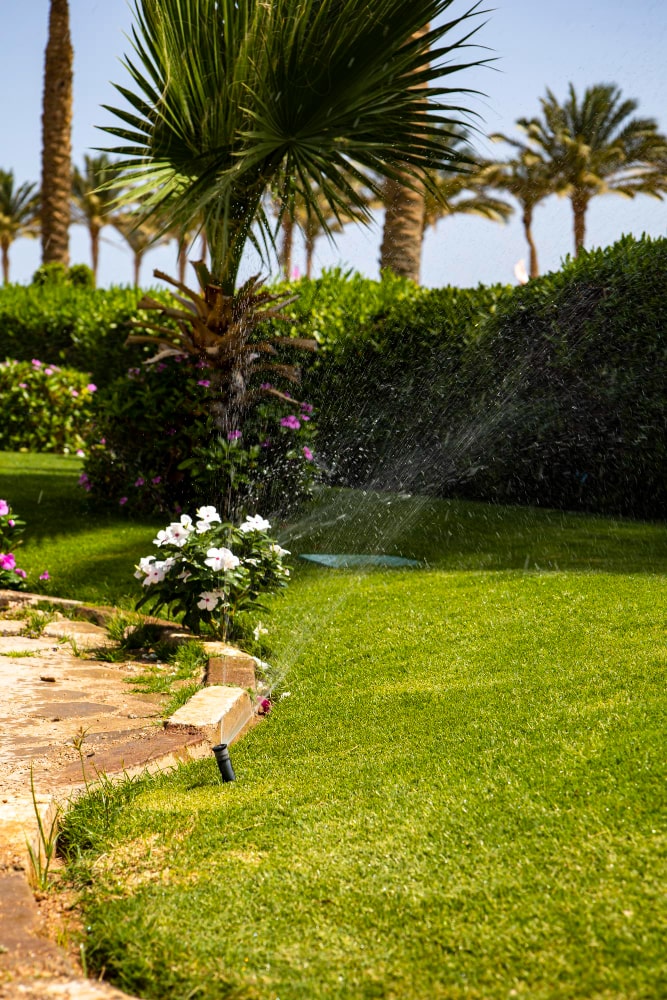
Modern irrigation technology can take most of the work out of keeping your plants hydrated:
System Types:
- Drip irrigation: Think of drip systems as the sniper rifle of watering – they precisely target plant roots through special tubing, using up to 90% less water than old-school sprinklers that spray everywhere.
- Smart controllers: These Wi-Fi-enabled devices adjust watering based on local weather conditions. Some even connect to soil moisture sensors for perfect watering every time.
- Soaker hoses: An inexpensive alternative to drip systems, these porous hoses release water along their entire length. Best for vegetable gardens or densely planted beds.
Installation Tips:
- Zone your system by plant water needs
- Include a rain sensor to avoid watering during storms
- Schedule watering for early morning to reduce evaporation
- Winterize systems in cold climates to prevent freezing damage
Cost Note: While the initial investment might seem high, a well-designed irrigation system often pays for itself in water savings within a few years.
6. Evergreens for Year-Round Interest
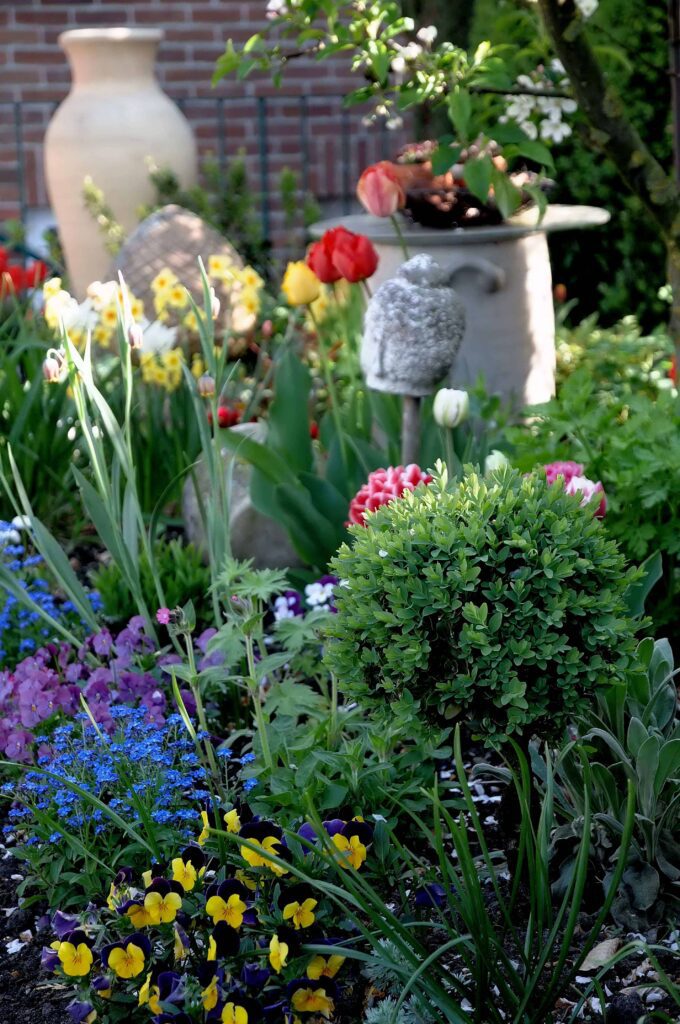
Unlike deciduous plants that lose their leaves, evergreens maintain their foliage all year, providing constant structure and color to your landscape:
Top Low-Maintenance Choices:
- Boxwoods: These classic shrubs maintain their neat, rounded shape with just one annual pruning. Smaller varieties like ‘Green Velvet’ stay compact naturally.
- Dwarf Alberta Spruce: This slow-growing conifer forms a perfect cone shape without pruning. Its soft blue-green foliage adds year-round color, and it rarely exceeds 6-8 feet tall.
- Holly bushes: Glossy green leaves and bright red berries make hollies a winter standout. Most varieties are drought-tolerant once established and need minimal pruning.
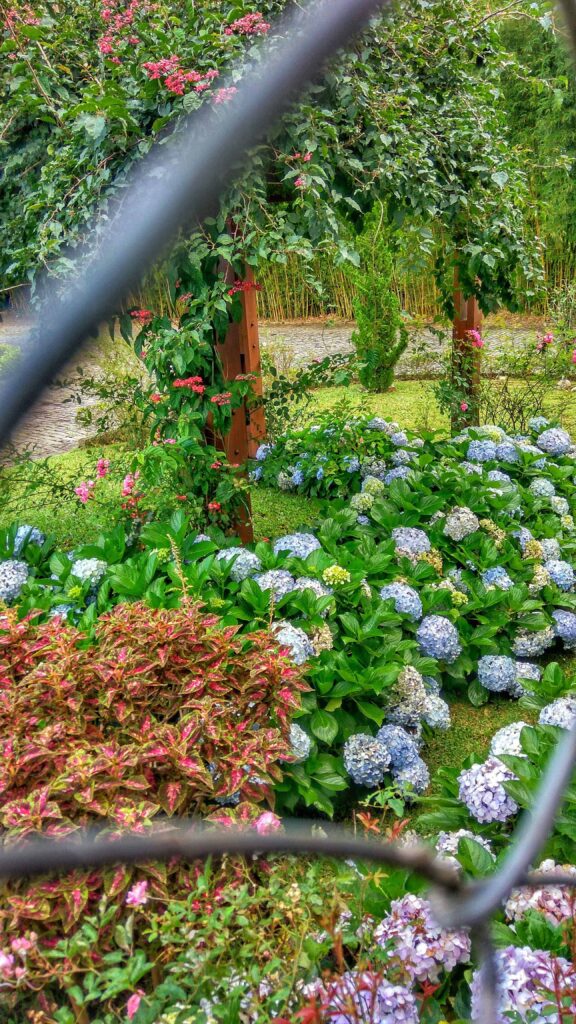
Placement Ideas:
- Frame your front door with matching evergreens
- Use as corner markers to define your property lines
- Plant in groups of three for visual impact
- Combine different textures (needles vs. broadleaf) for interest
Wildlife Bonus: Many evergreens provide winter shelter for birds and other small creatures.
7. Container Gardening for Flexible Beauty
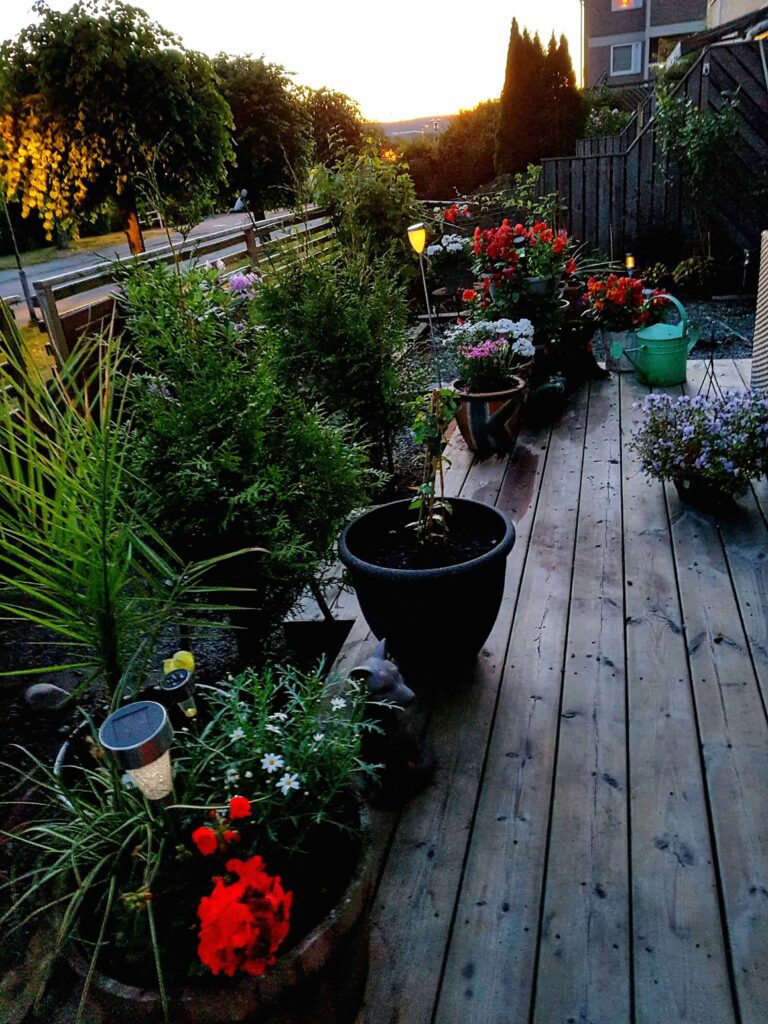
Potted plants offer several advantages for low-maintenance landscaping:
Benefits:
- No weeding (containers are naturally weed-resistant)
- Easy to move as needed for sun exposure or design changes
- It can be brought indoors in cold climates.
- Do you have tough clay soil or super sandy ground? No problem! Pots allow you to create the perfect growing conditions for plants that would normally say ‘no thanks’ to your native soil.
Best Low-Maintenance Plants for Containers:
- Dwarf citrus trees: Varieties like Meyer lemon or kumquat stay small but produce full-sized fruit. They’re perfect for sunny patios.
- Ornamental grasses: Fountain grass or blue fescue adds movement and texture with minimal care.
- Succulents: Hens-and-chicks or agave thrive in containers and need very little water.
Container Care Tips:
- Choose pots with drainage holes
- Use high-quality potting mix
- Water deeply but less frequently to encourage strong roots
- Apply slow-release fertilizer at planting time
Design Idea: Group containers in odd numbers (3 or 5) at varying heights for visual appeal.
8. Artificial Turf for Always-Green Perfection
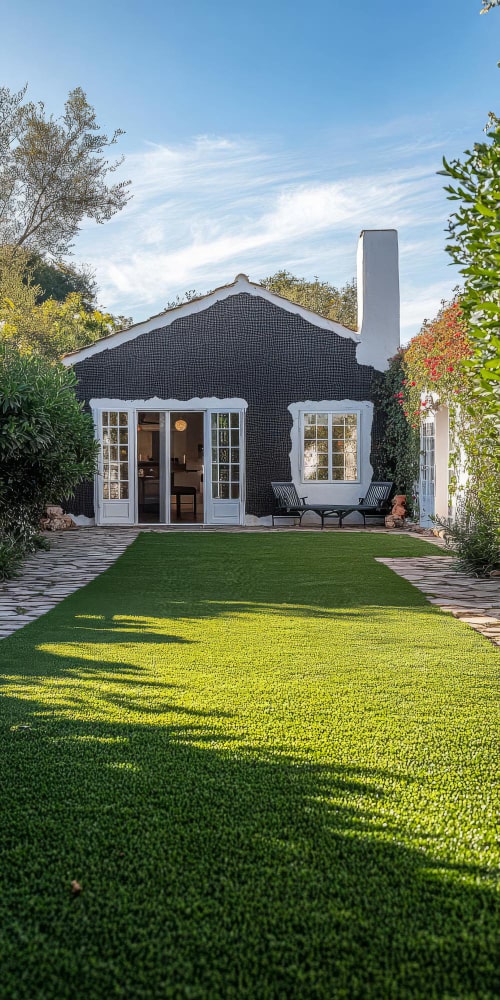
Modern synthetic grass has come a long way from the obvious “plastic” look of early versions:
Today’s Options Feature:
- Multiple blade colors and lengths for a realistic appearance
- UV protection to prevent fading
- Drainage holes to prevent puddling
- Pet-friendly varieties that resist odors and stains
Best Uses:
- Small front yards where mowing is difficult
- Shady areas where grass won’t grow
- Play spaces that get heavy use
- Combining with real plants for a mixed look
Installation Tips:
- Prepare a proper base of compacted gravel
- Pick a pro installer for top-quality work
- Consider adding a putting green for fun
- Use in moderation – small areas look more natural than entire yards
Maintenance: Just occasional rinsing and brushing to keep blades upright.
9. Ground Covers That Suppress Weeds

These spreading plants form living mulch that blocks weeds while adding beauty:
Top Performers:
- Vinca minor (Periwinkle): Glossy leaves and purple spring flowers. It spreads quickly in the shade.
- Pachysandra: Forms a dense carpet of shiny green leaves. Ideal for deep shade.
- Ajuga (Bugleweed): Bronze or variegated foliage with blue flower spikes. Tolerates light foot traffic.
Planting Tips:
- Space plants, according to their spread rate
- Water regularly until established
- Edge beds to contain vigorous spreaders
- Combine with spring bulbs for seasonal color
Eco-Bonus: Ground covers prevent soil erosion and provide a habitat for beneficial insects.
10. Design With Curves for Natural Appeal

Straight lines and perfect edges require constant maintenance to look sharp. Gentle curves, on the other hand:
Benefits:
- Hide imperfections in plant growth
- Create a more organic, flowing look
- Are easier to maintain with string trimmers
- Make small spaces appear larger
How to Implement:
- Use a garden hose to lay out potential curves
- Step back and view from multiple angles
- Adjust until you’re happy with the flow
- Mark with spray paint before cutting the edges
Curved Element Ideas:
- Planting bed borders
- Pathway edges
- Lawn shapes
- Mulch or gravel areas
Designer Trick: Repeat the same curve in multiple areas of your yard to create cohesion.
11. Low-Maintenance Flowering Plants

Enjoy seasonal color without constant deadheading or staking:
Best Choices:
- Coneflowers (Echinacea): Tough perennials with months of blooms. Keep seeds for winter texture and bird snacks.
- Daylilies (Hemerocallis): Each flower lasts just one day, but plants produce dozens in succession. Foliage stays attractive all season.
- Coreopsis: Cheerful yellow flowers from early summer to fall. ‘Moonbeam’ variety is particularly long-blooming.
Care Tips:
- Choose disease-resistant varieties
- Plant in masses for maximum impact
- Combine with ornamental grasses for texture contrast
- Mulch to conserve moisture and reduce weeds
Bonus: Many of these plants make excellent cut flowers, too.
12. Functional Hardscape Features
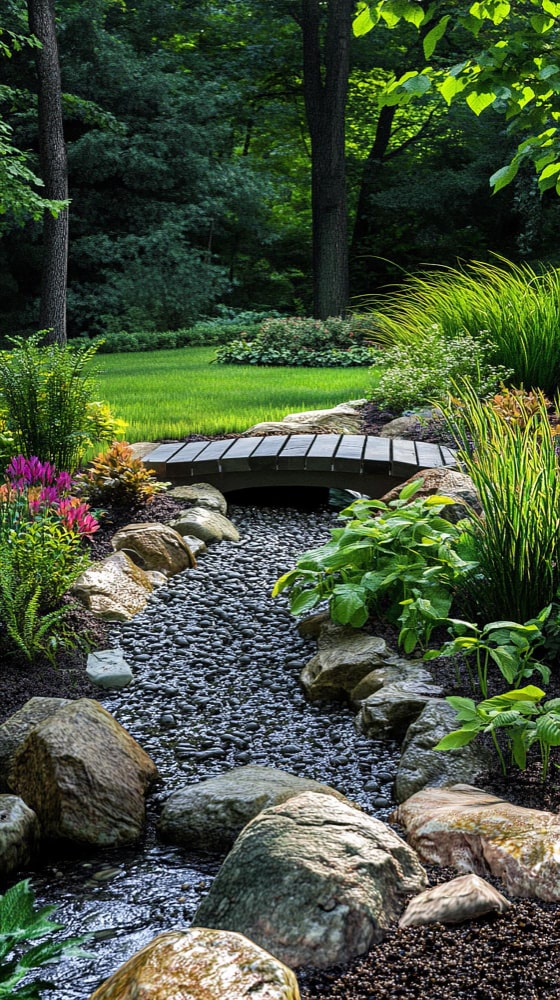
Choose elements that solve problems while adding beauty:
Multi-Tasking Options:
- Retaining walls: Hold back soil while providing casual seating. Use natural stone for timeless appeal.
- Pebble mosaics: Create decorative patterns that also improve drainage in wet areas.
- Arbors: Define entryways while supporting climbing roses or clematis.
Material Choices:
- Natural stone (most durable, most expensive)
- Concrete pavers (uniform look, moderate cost)
- Reclaimed brick (eco-friendly, rustic charm)
- Pressure-treated wood (affordable but needs occasional treatment)
Installation Tip: Always prepare a proper base – at least 4-6 inches of compacted gravel – to prevent settling.
13. Native Plants for Easy Care
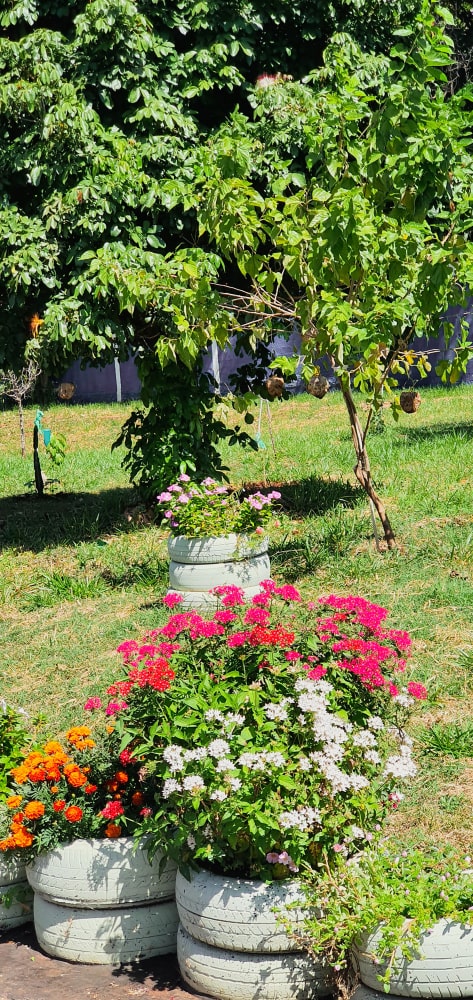
Native plants are already pros at thriving in your area’s climate and soil – they’ve been doing it for centuries!
Advantages:
- Need less water once established
- Resist local pests and diseases
- Support native wildlife
- Typically require less fertilizer
How to Get Started:
- Contact your local cooperative extension office
- Visit native plant nurseries
- Join a local native plant society
- Start small with a few easy species
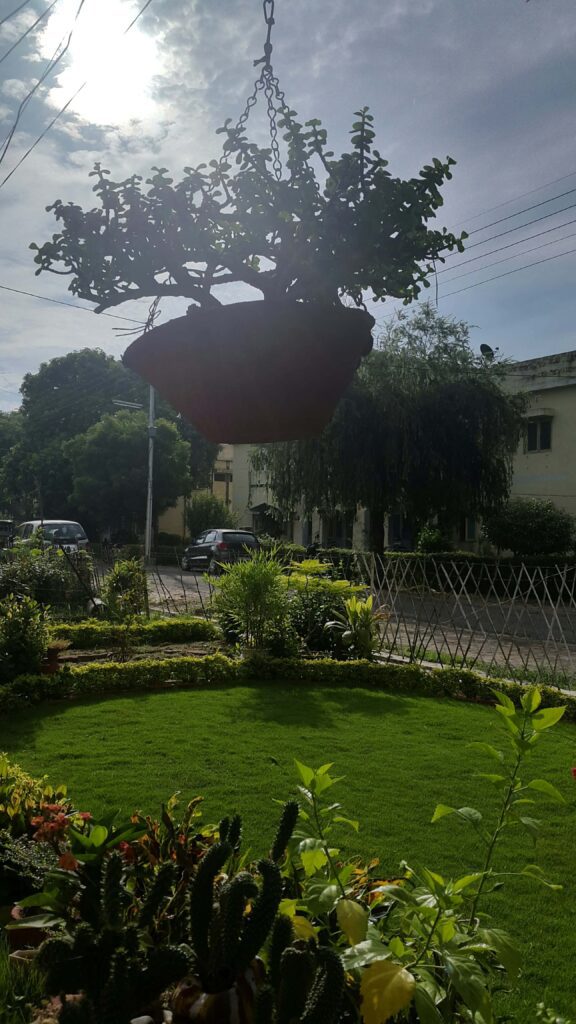
Beginner-Friendly Natives:
- Milkweed (for monarch butterflies)
- Black-eyed Susans
- Native grasses like switchgrass
- Regional oak species
Ecological Benefit: Native plants support 29 times more biodiversity than non-natives.
14. Solar Lighting for Automatic Ambiance
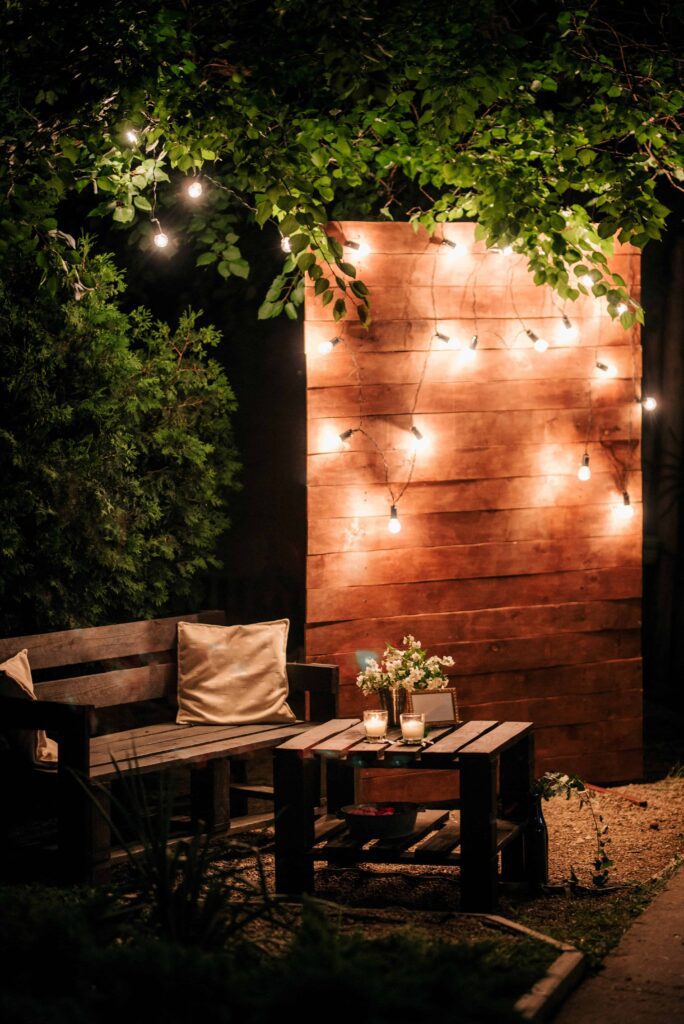
No wiring or electricity bills are required:
Types of Solar Lights:
- Path lights: Low-profile fixtures that mark walkways
- Spotlights: Highlight trees or architectural features
- String lights: Create a party-ready atmosphere
- Lanterns: Add decorative accents to patios
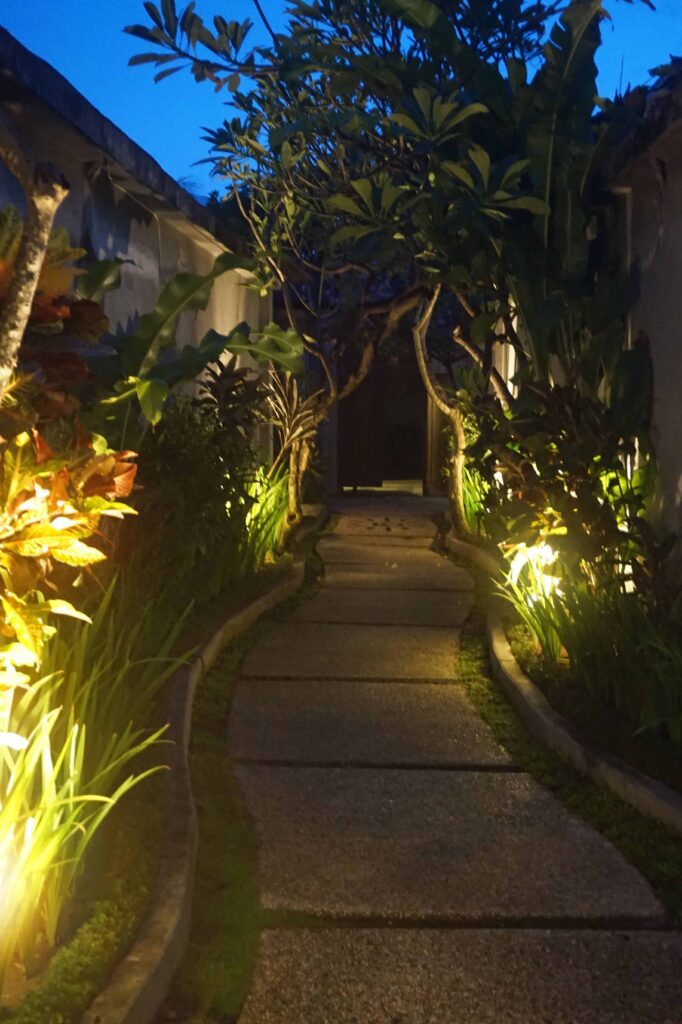
Placement Tips:
- Ensure solar panels get full sun
- Space path lights 6-8 feet apart
- Use warmer color temperatures (2700K-3000K) for a cozy glow
- Clean solar panels occasionally for best performance
Technology Update: New lithium battery models last longer and perform better in winter.
15. Embrace Imperfection For Low-Maintenance Front Yard Landscaping

Sometimes, the lowest-maintenance approach is simply adjusting expectations:
Stress-Reducing Strategies:
- Leave some fallen leaves as natural mulch
- Allow edges to soften slightly between trimmings
- Let self-seeding plants pop up where they please
- Designate “wild zones” where nature takes the lead
Mindset Shifts:
- View “weeds” as potential wildflowers
- Appreciate the changing seasons
- Focus on overall impression rather than perfection
- Remember that gardens are living, evolving spaces
Final Thought: Your yard should bring you joy, not stress. A slightly wilder look often has more charm than rigid perfection.
Final Thought
Low maintenance doesn’t mean low impact. Start with just 2-3 changes (maybe mulch + a tough plant swap?), and watch your free time—and curb appeal—grow.
Which idea speaks to you? Tag us in your yard glow-ups—we’ll cheer you on!

